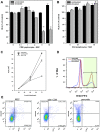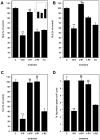Activated CD8+ T lymphocytes inhibit neural stem/progenitor cell proliferation: role of interferon-gamma
- PMID: 25133679
- PMCID: PMC4136865
- DOI: 10.1371/journal.pone.0105219
Activated CD8+ T lymphocytes inhibit neural stem/progenitor cell proliferation: role of interferon-gamma
Abstract
The ability of neural stem/progenitor cells (NSCs) to self-renew, migrate to damaged sites, and differentiate into neurons has renewed interest in using them in therapies for neurodegenerative disorders. Neurological diseases, including viral infections of the brain, are often accompanied by chronic inflammation, whose impact on NSC function remains unexplored. We have previously shown that chronic neuroinflammation, a hallmark of experimental herpes simplex encephalitis (HSE) in mice, is dominated by brain-infiltrating activated CD8 T-cells. In the present study, activated CD8 lymphocytes were found to suppress NSC proliferation profoundly. Luciferase positive (luc+) NSCs co-cultured with activated, MHC-matched, CD8+ lymphocytes (luc-) showed two- to five-fold lower luminescence than co-cultures with un-stimulated lymphocytes. On the other hand, similarly activated CD4+ lymphocytes did not suppress NSC growth. This differential lymphocyte effect on proliferation was confirmed by decreased BrdU uptake by NSC cultured with activated CD8 T-cells. Interestingly, neutralizing antibodies to interferon-gamma (IFN-γ) reversed the impact of CD8 lymphocytes on NSCs. Antibodies specific to the IFN-γ receptor-1 subunit complex abrogated the inhibitory effects of both CD8 lymphocytes and IFN-γ, indicating that the inhibitory effect of these cells was mediated by IFN-γ in a receptor-specific manner. In addition, activated CD8 lymphocytes decreased levels of nestin and Sox2 expression in NSCs while increasing GFAP expression, suggesting possible induction of an altered differentiation state. Furthermore, NSCs obtained from IFN-γ receptor-1 knock-out embryos were refractory to the inhibitory effects of activated CD8+ T lymphocytes on cell proliferation and Sox2 expression. Taken together, the studies presented here demonstrate a role for activated CD8 T-cells in regulating NSC function mediated through the production of IFN-γ. This cytokine may influence neuro-restorative processes and ultimately contribute to the long-term sequelae commonly seen following herpes encephalitis.
Conflict of interest statement
Figures





Similar articles
-
Glial cells suppress postencephalitic CD8+ T lymphocytes through PD-L1.Glia. 2014 Oct;62(10):1582-94. doi: 10.1002/glia.22701. Epub 2014 Jun 3. Glia. 2014. PMID: 24890099 Free PMC article.
-
Modulation of neural stem/progenitor cell proliferation during experimental Herpes Simplex encephalitis is mediated by differential FGF-2 expression in the adult brain.Neurobiol Dis. 2013 Oct;58:144-55. doi: 10.1016/j.nbd.2013.05.018. Epub 2013 Jun 5. Neurobiol Dis. 2013. PMID: 23748078 Free PMC article.
-
IFN-γ-STAT1-mediated CD8+ T-cell-neural stem cell cross talk controls astrogliogenesis after spinal cord injury.Inflamm Regen. 2023 Feb 13;43(1):12. doi: 10.1186/s41232-023-00263-9. Inflamm Regen. 2023. PMID: 36782279 Free PMC article.
-
[Interleukin-12 restores and promotes the T-cell immune function inhibited by 5-fluorouracil].Ai Zheng. 2007 Aug;26(8):801-8. Ai Zheng. 2007. PMID: 17697537 Chinese.
-
Unfolded protein response in the activation-induced biological processes of CD8+ T cells.Pharmacol Res. 2021 Jul;169:105654. doi: 10.1016/j.phrs.2021.105654. Epub 2021 May 6. Pharmacol Res. 2021. PMID: 33964469 Review.
Cited by
-
Systemic inflammation and the brain: novel roles of genetic, molecular, and environmental cues as drivers of neurodegeneration.Front Cell Neurosci. 2015 Feb 2;9:28. doi: 10.3389/fncel.2015.00028. eCollection 2015. Front Cell Neurosci. 2015. PMID: 25698933 Free PMC article. Review.
-
Effect of Transcutaneous Electrical Acupoint Stimulation Combined with Transversus Abdominis Plane Block on Postoperative Recovery in Elderly Patients Undergoing Laparoscopic Gastric Cancer Surgery: A Randomized Controlled Trial.Pain Ther. 2022 Dec;11(4):1327-1339. doi: 10.1007/s40122-022-00429-2. Epub 2022 Sep 13. Pain Ther. 2022. PMID: 36098938 Free PMC article.
-
Impact of radiotherapy on immunological parameters, levels of inflammatory factors, and clinical prognosis in patients with esophageal cancer.J Radiat Res. 2019 May 1;60(3):353-363. doi: 10.1093/jrr/rrz006. J Radiat Res. 2019. PMID: 31034571 Free PMC article.
-
Effects of Acyclovir and IVIG on Behavioral Outcomes after HSV1 CNS Infection.Behav Neurol. 2017;2017:5238402. doi: 10.1155/2017/5238402. Epub 2017 Nov 19. Behav Neurol. 2017. PMID: 29358844 Free PMC article.
-
The antiviral cytokine interferon-gamma restricts neural stem/progenitor cell proliferation through activation of STAT1 and modulation of retinoblastoma protein phosphorylation.J Neurosci Res. 2017 Aug;95(8):1582-1601. doi: 10.1002/jnr.23987. Epub 2016 Nov 15. J Neurosci Res. 2017. PMID: 27862183 Free PMC article.
References
-
- Gage FH (2000) Mammalian neural stem cells. Science 287: 1433–1438. - PubMed
-
- Merkle FT, Mirzadeh Z, Alvarez-Buylla A (2007) Mosaic organization of neural stem cells in the adult brain. Science 317: 381–384. - PubMed
-
- Kempermann G (2011) Adult Neurogenesis 2: Stem Cells and Neuronal Development in the Adult Brain. New York: Oxford University Press. 426 p.
-
- Kempermann G, Jessberger S, Steiner B, Kronenberg G (2004) Milestones of neuronal development in the adult hippocampus. Trends Neurosci 27: 447–452. - PubMed
Publication types
MeSH terms
Substances
Grants and funding
LinkOut - more resources
Full Text Sources
Other Literature Sources
Molecular Biology Databases
Research Materials
Miscellaneous

